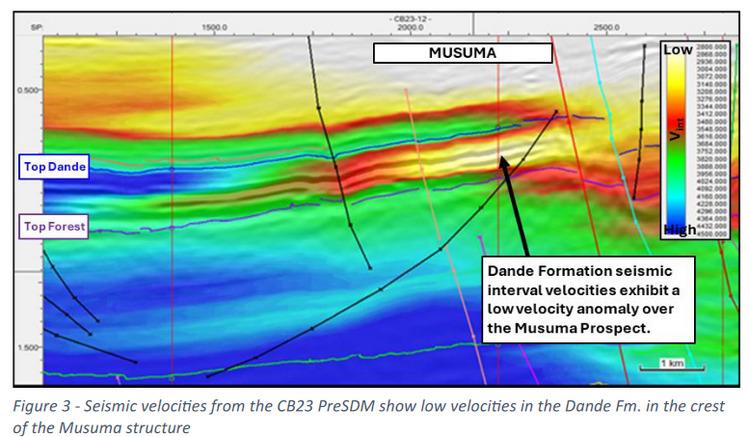
HIGHLIGHTS
- Interpretation of new 2D seismic data completed and prospect evaluation underway for eastern exploration licence areas
- Multiple prospects have been identified in the Dande Formation with seismic amplitude characteristics suggestive of reservoired hydrocarbons
- Potential for single large accumulation based on amplitude response
- Mapping of deeper horizons in progress to assist with selection of exploration well locations
Invictus Energy has provided an update on the interpretation of new Cabora Bassa 2023 2D Infill Seismic Survey ('CB23 survey') results from its 80% owned and operated Cabora Bassa Project in Zimbabwe.
Multiple amplitude-supported prospects identified in Dande Formation
Since receiving all the final data processing deliverables from the seismic processing contractor, Invictus has been interpreting newly acquired seismic data of the CB23 survey.
The interpretation is largely complete and multiple seismic amplitude-supported prospects in the Dande Formation have been mapped. Whilst mapped as individual prospects, the amplitude responses across the three structures could be interpreted as being part of a single, large accumulation.
Further work is underway to mature the Musuma, Mopane and Mururo prospects to drill-ready for a future exploration drilling campaign.
Invictus Energy Managing Director Scott Macmillan commented:
'Newly mapped amplitude-supported prospects in the Dande Formation that have been revealed through the CB23 Seismic Survey we acquired last year are very exciting.
'The fact we see the seismic amplitude response across the Musuma, Mopane and Mururo prospects in the south-east of our exploration licence area is extremely encouraging, and could ultimately be part of a single, large hydrocarbon accumulation.
'The Dande Formation targets are relatively shallow (sub-1,200m) and can be tested with a simple low-cost vertical well.
'The Company continues to evaluate the CB23 survey data and these exciting new prospects alongside others in the portfolio, including the untested Basin Margin play, to mature them to drill-ready for an upcoming exploration drilling campaign.'
Interpreted seismic amplitude-support for Dande Formation prospects
Through Q1 2024 the Company has completed an interpretation of the processed seismic data, tying in key subsurface features to the existing seismic dataset and incorporating insights from the Mukuyu well data.
This has allowed for the maturation of several potentially amplitude-supported prospects in the Dande Formation (Figure 1).

The presence of a hydrocarbon accumulation in a porous reservoir rock has the physical effects of reducing the density and seismic velocity of the host rock.
In favourable circumstances this effect can be recognised in seismic datasets as seismic amplitude or velocity anomalies.
In general, this seismic ‘amplitude support’ (for the presence of hydrocarbons) is favoured by better reservoir porosities, lighter hydrocarbons (gas) and shallower reservoir depths.
The presence of consistent amplitude anomalies across different seismic datasets (CB23, CB21 and legacy 1990 Mobil survey) and processing vintages adds confidence to their interpretation and, by inference, the presence of genuine hydrocarbon-related amplitude anomalies significantly increases the chance of a valid trap being present.
Figure 2 below shows line CB23-15 through the Musuma and Mopane prospects. The line shows potential flat spots (which are horizontal seismic features generated by a hydrocarbon-water fluid contact in a porous reservoir) and up-dip reflector brightenings (which come from dipping reservoirs passing through a horizontal hydrocarbon-water fluid contact) in the Dande and top of the underlying Forest Formations.

Similar features are observed at a consistent depth across multiple lines from the CB23 survey and also on lines from Invictus’ Cabora Bassa 2021 (CB21) 2D survey and the legacy 1990 2D dataset.
The seismically-derived subsurface velocities (Figure 3) also exhibit a decrease in velocity which may be attributable to the presence of hydrocarbons in the Dande Formation in the crest of the prospect.

Mukuyu wells confirm Dande as a prospective new play
Whilst the wells were primarily sited to test the Pebbly Arkose and Angwa Formations, the Dande Formation was recognised as a potential secondary target at the time of drilling Mukuyu-1 and Mukuyu-2.
At Mukuyu-2 the well encountered good quality Dande reservoir and the presence of residual hydrocarbons was interpreted based on wireline logs and elevated mudgas readings.
This presence of effective reservoir sands in the Dande Formation makes it a viable exploration target elsewhere in the basin.
Sidewall cores acquired through the Dande during the drilling of Mukuyu-2 are currently being prepared in the laboratory for analysis to confirm key reservoir properties including porosity and permeability.
No sidewall cores were acquired over the Dande in Mukuyu-1.
The Cabora Bassa 2023 (CB23) 2D Seismic Survey
The CB23 survey was acquired by Invictus in mid-2023 to provide an additional 425km of modern, high-quality seismic data over prospects identified on Invictus’ 2021 2D survey and a reprocessed legacy 2D dataset from 1990.

The new lines infill the legacy seismic grid to give line spacings down to approximately 1km over the prospects (Figure 4).
The data was processed during Q4 2023 through a pre-stack depth migration (PreSDM) workflow to provide a high-quality image of the subsurface and an associated velocity model.
Source: Invictus Energy










